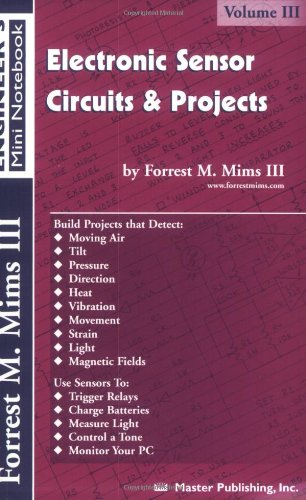Electronic Sensor Circuits & Projects ebook download
Par bass derek le jeudi, août 18 2016, 06:31 - Lien permanent
Electronic Sensor Circuits & Projects by Forrest M. Mims III


Electronic Sensor Circuits & Projects Forrest M. Mims III ebook
Publisher: Master Publishing, Inc.
Format: djvu
ISBN: 0945053312, 9780945053316
Page: 26
Been designed and fabricated using sound intensity sensor and display unit. Let me provide you some of my previous RC projects: a. This tiny circuit has no voltage source, it rather converts Rf radiations into Electric current and glow an LED =D This is most awesome project on this entire site! Here condenser microphone is used as sensor of noise meter with operational amplifier (IC2) and corresponding passive components. There are some kinds of LM35 IC, since it is cheap and easy to find we used LM35DZ in our project. The circuit applies readily available electronic parts and the circuit design is simple. The premise is simple: most electronic projects are just electronic Lego. You might have done similar projects using transistors. You connect With this, all you need for a final circuit board is to create a new board file, hit the autorouter, and spend a half hour fixing whatever mess the autorouter made. As shown in the schematic, temperature sensor of our electronic thermometer is LM35DZ. Electronic Noise meter circuit can be build using op-amp and monolithic IC..measure sound intensity and noise level and display with warning beep..circuit diagram with descriptionLED project. This is a simple RC circuit using thyristor. Hi, i'm working on a project at school and have a problem with using a sensor to trigger a transistor. A common piezo sensor is applied to detect vibrations/sounds because of pressure variations. If you're working on a high altitude balloon project, there's already a project out there with a microcontroller, barometric pressure sensor, and an SD card somewhere out there in a corner of the Internet. Light Sensor Using Arduino: Same circuit, but using Arduino code for simpler and messing up the if else statement in there is really fun! It measures from 0°C to 100°C with a very linear output graph.For one degree change, For proper operation, voltage values of the nodes shown in the circuit must be adjusted to 90mV, 190mV, 290mV and 390mV by using multiturn trimpots. On this site, This Project is linked by many of the Electronics Websites.